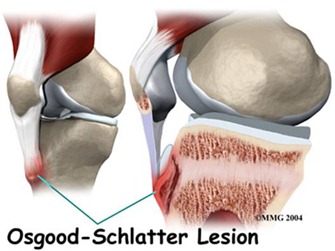Osgood Schlatters Disease
Posted on January 26th, 2012 by Andries

Overuse injuries are increasing among young athletes. This type of injury is the result of an increasing load on the musculoskeletal structures. The problem develops over time due to repeated stress and can be very painful and frustrating that leads to a chronic problem.
Osgood Schlatter disease: Inflammation and swelling at the site of insertion of the main quadriceps tendon at the top of the tibia (the tibial tubercle) just below the knee. It is common in
adolescence and result from excessive physical activity. Most cases resolve with time and rest.
It occurs most frequently in the younger athlete, due to the differences in structure and anatomy of the growing bone compared with that of the adult leg. The structural differences between the adult and growing bone is as follows:
- The articular cartilage of growing bone is thicker than in the adult bone, and the ability to remodel.
- The tendon attachments seat to the growing bone consists of relatively weak cartilage plate, the incidence of avulsion fractures may be increased.
- The metaphysis of long bones in children is more elastic and flexible, which causes the incomplete fractures (“greenstick” fractures) occurring only in children.
- With rapid growth phases extending the leg faster than the muscle and tendon can stretch. This causes temporary coordination and movement problems.
- Because of these differences, the younger athlete is more prone to cartilage and bone injuries, or a complete avulsion of the apophysis.
Osgood Schlatter presenting as anterior knee pain, usually associated with overuse or activity. The pain is felt by the attachment of the patella tendon to the tibial tubercle. The athlete will complain of pain during activities such as running, jumping, kneeling, squatting and up and down of stairs. In a sitting position with the knee in 90 ° flexion, a bony enlargement of the tibial tubercle is observed. Local tenderness over the anterior proximal tibial tubercle on palpation is a positive sign. The repeated irritation causes swelling, bleeding and gradual degeneration of the apophysis, which causes impaired circulation.
An effective examination of the lower limbs should be done to determine the extent of movement, particularly the flexibility of the hamstring and quadricep muscles. Muscle tests should be made to the strength in the knee and hip testing. The feet should also be tested for movement patterns that can lead to malalignment of knee injuries. Typical findings are external hip rotation, abduction movements and poor flexibility in the hamstring and quadricep muscles. Extension movements against a resistance will cause pain. Biomechanical tests that can be done include walking pattern, single and double leg squat (squat).
This condition is usually due to overuse. Overuse injuries are completely preventable for most young athletes. It is the responsibility of the parents and the coach to make sure that the young athlete’s program is not too demanding.Treatment is usually conservative. The goal of treatment is to reduce pain, increase strength and flexibility. Pain should be the main guideline to dictate the amount of activity.
Tweet